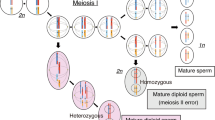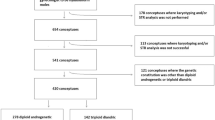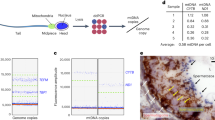Summary
Complete hydatidiform moles contain only paternal chromosomes. To learn more of their origin, we used restriction endonuclease site polymorphisms found in the parental mitochondrial DNAs to demonstrate that moles contain exclusively maternal mitochondrial DNA. Thus, moles must arise from the fusion of one or two sperm with a mature but anucleate ovum.
Similar content being viewed by others
References
Anderson S, Bankier AT, Barrell BG, Bruijn MHL de, Coulson AR, Drouin J, Eperon IC, Nierlich DP, Roe BA, Sanger F, Schreier PH, Smith AJH, Staden R, Young IG (1981) Sequence and organization of the human mitochondrial genome. Nature 290:457–465
Bieber FR, Nance WE, Morton CC, Brown JA, Redwine FO (1981) Genetic studies of an acardiac monster: evidence of polar body twinning in man. Science 213:775–777
Blin N, Stafford DW (1976) A general method for isolation of high molecular weight DNA from eukaryotes. Nucleic Acids Res 3: 2303–2308
Case JT, Wallace DC (1981) Maternal inheritance of mitochondrial DNA polymorphisms in cultured human fibroblasts. Somatic Cell Genet 7:103–108
Denaro M, Blanc H, Johnson MJ, Chen KH, Wilmsen E, Cavalli-Sforza LL, Wallace DC (1981) Ethnic variation in Hpa I endonuclease cleavage patterns of human mitochondrial DNA. Proc Natl Acad Sci USA 78:5768–5772
Giles RE, Blanc H, Cann HM, Wallace DC (1980a) Maternal inheritance of human mitochondrial DNA. Proc Natl Acad Sci USA 77: 6715–6719
Giles RE, Stroynowski I, Wallace DC (1980b) Characterization of mitochondrial DNA in chloramphenicol-resistant interspecific hybrids and a cybrid. Somatic Cell Genet 6:543–554
Gresson RAR (1940) Presence of the sperm middle-piece in the fertilized egg of the mouse (Mus musculus). Nature 145:425
Gresson RAR (1941) A study of the cytoplasmic inclusions during maturation, fertilization and the first cleavage division of the egg of the mouse. J Microscop Sci 83:35–60
Jacobs PA, Wilson CM, Sprenkle JA, Rosenshein NB, Migeon BR (1980) Mechanism of origin of complete hydatidiform moles. Nature 286:714–716
Kajii T, Ohama K (1977) Androgenetic origin of hydatidiform mole. Nature 268:633–634
Ohama K, Kajii T, Okamoto E, Fukuda Y, Imaizumi K, Tsukahara M, Kobayashi K, Hagiwara K (1981) Dispermic origin of XY hydatidiform moles. Nature 292:551–552
Pattillo RA, Sasaki S, Katayama KP, Roesler M, Mattingly RF (1981) Genesis of 46,XY hydatidiform mole. Am J Obstet Gynecol 141: 104–105
Ringertz NR, Savage RE (1976) Cell hybrids. Academic Press, New York
Shipman C Jr, Smith SH, Drach JC (1972) Selective inhibition of nuclear DNA synthesis by 9-β-d-arabinofuranosyl adenine in rat cells transformed by Rous sarcoma virus. Proc Natl Acad Sci USA 69:1753–1757
Southern EM (1975) Detection of specific sequences among DNA fragments separated by gel electrophoresis. J Mol Biol 98:503–517
Surti U, Szulman AE, O'Brien S (1979) Complete (classic) hydatidiform mole with 46,XY karyotype of paternal origin. Hum Genet 51: 153–155
Surti U, Szulman AE, O'Brien S (1982) Dispermic origin and clinical outcome of three complete hydatidiform moles with 46,XY karyotype. Am J Obstet Gynecol (Accepted for publication)
Szulman AE, Surti U (1978a) The syndromes of hydatidiform mole II. Morphologic evolution of the complete and partial mole. Am J Obstet Gynecol 132:20–27
Szulman AE, Surti U (1978b) The syndromes of hydatidiform mole I. Cytogenetic and morphologic correlations. Am J Obstet Gynecol 131:665–671
Wallace DC, Assignment of the chloramphenicol resistance gene to mitochondrial deoxyribonucleic acid and analysis of its expression in cultured human cells. Mol Cell Biol 1:697–710
Wallace DC, Bunn CL, Eisenstadt JM (1975) Cytoplasmic transfer of chloramphenicol resistance in human tissue culture cells. J Cell Biol 67:174–188
Wallace DC, Bunn CL, Eisenstadt JM (1977) Mitotic segregation of cytoplasmic determinants for chloramphenicol resistance in mammalian cells II: fusions with human cell lines. Somatic Cell Genet 3:93–119
Yamashita K, Wake N, Araki T, Ichinoe K Kuroda M (1981) A further HLA study of hydatidiform moles. Gynecol Oncol 11:23–28
Author information
Authors and Affiliations
Rights and permissions
About this article
Cite this article
Wallace, D.C., Surti, U., Adams, C.W. et al. Complete moles have paternal chromosomes but maternal mitochondrial DNA. Hum Genet 61, 145–147 (1982). https://doi.org/10.1007/BF00274205
Received:
Revised:
Issue Date:
DOI: https://doi.org/10.1007/BF00274205




